WATER-RELATED INJURIES
SNORKELING AND SCUBA DIVING
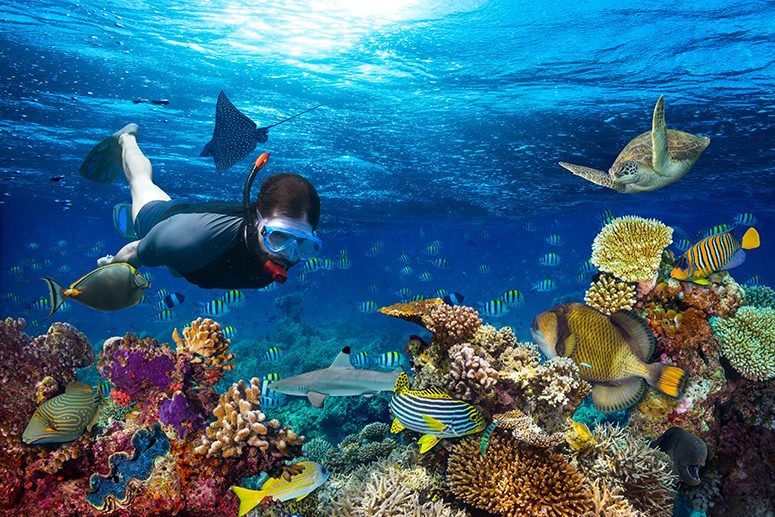
Snorkeling
Snorkeling is swimming while using a mask and snorkel and sometimes other equipment such as a wetsuit or fins. Snorkelers typically stay just below the water’s surface, but they may make breath-hold dives to lower depths. In contrast to scuba diving, which is generally perceived as a risky activity that requires training and certification, snorkeling is considered harmless. As a result, most snorkelers do not receive proper training.
Most people get involved with the sport on an opportunistic basis without much planning or forethought. It is possible to start snorkeling on your own or through a resort recreation program. Such programs typically rent snorkeling equipment and take snorkelers to interesting areas but don’t offer much instruction, assistance or emergency preparedness. A preparticipation health screening is rarely required or is conducted ad hoc by nonmedical personnel.
The major risk for snorkelers is drowning, which can occur due to sudden cardiac arrest, immersion pulmonary edema, hypoxic blackout, water inhalation, being struck by a watercraft, strong water movement from tides or currents, and other mishaps.
Sudden cardiac arrest and immersion pulmonary edema can affect any swimmer but are more likely to occur in older people and in people with preexisting medical conditions — especially hypertension (high blood pressure) and heart disease. For more information about cardiac health and water sports, see DAN.org/health-medicine/health-resource/dive-medical-reference-books/the-heart-diving.
Hypoxic blackout is a loss of consciousness due to lack of oxygen and can be caused by long breath-holding underwater. Average healthy young people can typically hold their breath for one to two minutes while resting on the surface; older people and those unaccustomed to physical activity generally have less breath-holding capability. Simultaneous exercise significantly reduces anyone’s breath-holding capacity, because exertion causes the body’s tissues to burn more oxygen. This means the duration of a breath-hold is much shorter while you are swimming underwater, especially if you are a weak or inefficient swimmer.
The warning sign that termination of a breath-hold should be imminent is an urge to breathe, which is caused by the accumulation of a critical level of carbon dioxide in the body. In some individuals, however, this urge can be very weak. It can also be postponed by repeated deep and fast breathing (hyperventilation) before submersion. Voluntary hyperventilation reduces the level of carbon dioxide in your blood far more than it adds oxygen.
As a consequence, it takes longer to reach a critical level of carbon dioxide — but during that extended time, your oxygen levels continue to drop, and unconsciousness can occur without the natural warning sign. To reduce hypoxic blackout risk, snorkelers should not practice hyperventilation. Even in the best circumstances, limit hyperventilation to one or at most two deep breaths before submersion.
Water inhalation can occur due to difficulty holding the snorkel in place or due to wave action. Dental issues may also contribute to water inhalation. The sudden inhalation of water can cause coughing, uncontrolled breathing, laryngospasm (an involuntary spasm of the muscles that control the windpipe, or larynx), flooding of the lungs with water, or the development of cardiac arrhythmia — any of which can render a snorkeler unconscious and result in drowning.
Being struck by watercraft is not uncommon for snorkelers or swimmers in high-traffic areas. Snorkelers should stay within visibly marked protected areas and pay attention to the boat traffic around them.
Strong water movement such as waves or currents can also overcome snorkelers, sweep them out to sea, tow them under the surface or throw them onto rocks. Snorkelers should always seek information about local water conditions and hidden hazards. Novice snorkelers should not swim in remote and unpopulated areas.
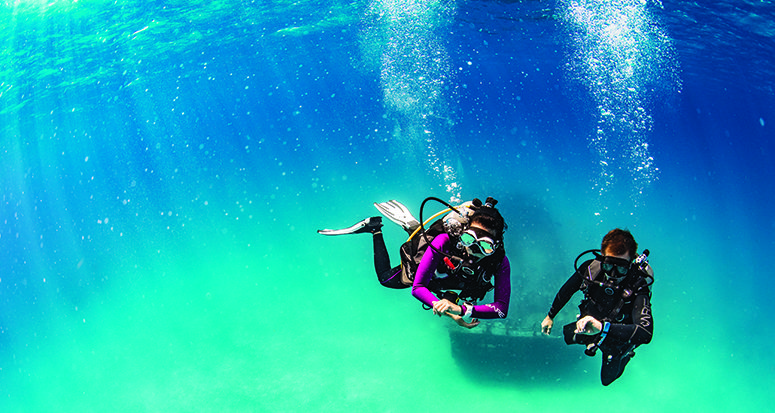
Scuba Diving
Diving can be an inspiring and enjoyable recreational activity, but many disorders can afflict divers who don’t take proper precautions. This guide will briefly discuss the two primary conditions — decompression illness and barotrauma — plus a few other concerns. DAN offers numerous publications that cover dive-related disorders in considerable detail; for more information, see DAN.org/health-medicine/health-resources.
Decompression illness (DCI): There are two forms of DCI: decompression sickness (DCS) and arterial gas embolism (AGE). DCS, also known as “the bends,” is one of the main hazards of compressed-gas diving. When a diver is breathing in an environment of elevated pressure, such as when scuba diving, inert gases such as nitrogen move into the body’s tissues and dissolve there. The body’s absorption of these inert gases, a process known as uptake, increases progressively with the dive’s depth and length. The longer a diver stays at depth, the more inert gases accumulate in the body. When the diver ascends toward the surface, the pressure decreases, and the gas starts to leave the body’s tissues. A diver’s ascent must be controlled to allow for the orderly elimination (or washout) of the accumulated gases as they’re transported by the blood to the lungs and exhaled. A slow ascent, conducted either continuously or in stages, usually allows for safe decompression, while a rapid ascent can result in the development of gas bubbles in the tissues and sometimes in symptoms of DCS.
DCS symptoms primarily reflect the effects of the gas bubbles in the affected tissues. The condition’s secondary effects can compromise the function of a broad range of tissues, further jeopardizing the affected diver’s health. Signs and symptoms of DCS include mild to moderate musculoskeletal pain and mild cutaneous (skin) sensory changes. More severe symptoms include neurological deficits (such as weakness in the lower extremities), an abnormal gait, paralyzis, vertigo, altered mental function and cardiopulmonary instability. For more information about DCS, see DAN.org/Health/Decompression.
Characterized by rapidly advancing neurologic symptoms following a dive, AGE is often a consequence of a rapid ascent to the surface while deliberately holding the breath — something that may happen when a diver panics. Certain medical conditions that cause intrapulmonary air trapping (the retention of excess air in the lungs), such as asthma or chronic obstructive pulmonary disease, can also increase the risk of AGE.
The appearance of any of these symptoms following a dive should prompt immediate attention and a call for assistance — including a call to DAN. Administer oxygen, check the victim’s hydration status, and arrange for evacuation if needed.
Barotrauma: Barotrauma is an injury caused by a difference in pressure between the ambient environment — whether on the surface or underwater — and an air-filled space in the body such as the middle ears and the sinuses. It is possible to have barotrauma of the lungs when scuba diving; other barotraumas can occur both in scuba and in freediving. Most common barotraumas affect ears and sinuses, but there are rare cases of dental and gastrointestinal barotrauma.
Symptoms of barotrauma include vertigo (dizziness), respiratory distress and cardiovascular instability. Prevent barotrauma by performing proper equalization — adjustment of middle-ear or sinus pressure to the ambient pressure by any of several techniques that enable air passage into the middle-ear cavity and sinuses.
Other concerns: Scuba divers need to understand the effects on the body of the various gases involved in respiration.
- Nitrogen: Nitrogen narcosis, sometimes called “the martini effect,” can result from breathing nitrogen at the higher partial pressure of compressed air, which increases with increased depth. It is characterized by an altered mental state that has been likened to mild intoxication.
- Carbon dioxide: An elevated level of carbon dioxide in the body due to exertion, incomplete exhalation or breath-holding can result in dyspnea (difficulty breathing), headache or an altered level of consciousness.
- Oxygen: Hypoxia, or lack of oxygen, can cause loss of consciousness, while hyperoxia, or elevated oxygen levels, can result in seizures (acute oxygen toxicity). Elevated carbon dioxide levels, immersion or exercise can intensify the latter effect. It is important to pay strict attention to oxygen levels, especially at maximum diving depths.
- Carbon monoxide: Carbon monoxide — a highly poisonous, odorless, colorless gas — is a product of incomplete combustion that can be found in exhaust from the engines of improperly ventilated boats, for example; it can occasionally be introduced into scuba tanks if they are carelessly filled. Symptoms of carbon monoxide poisoning initially include headache, nausea and fatigue and can progress to dizziness, seizures, respiratory arrest and even death. First aid should include the administration of supplemental oxygen.
Odor from a breathing gas can indicate a toxic compound. Immediately report any odors, no matter how faint, to a dive professional or the
filling station.
It is also vital for divers to understand the implications of flying or driving to a high elevation soon after diving. The lower pressure in an aircraft cabin or at altitude may cause decompression illness in previously asymptomatic divers or worsen existing symptoms. Divers without any DCI symptoms can use the following guidelines for surface intervals before flying in an unpressurized aircraft at altitudes of 2,000 to 8,000 feet (610 to 2,438 meters) or in a pressurized aircraft cabin:
- A preflight surface interval of at least 12 hours following a single no-decompression-stop dive
- A preflight surface interval of at least 18 hours following multiple dives per day or multiple days of diving
- A preflight surface interval of at least 24 hours following dives that require decompression stops
These suggested preflight surface intervals do not guarantee that a diver will avoid DCI, but longer surface intervals will further reduce the risk.
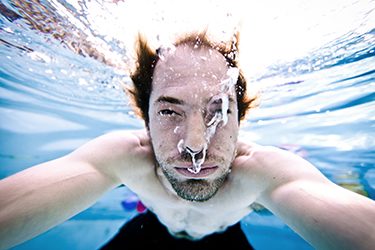
Hypoxic blackout is a loss of consciousness due to lack of oxygen and can be caused by long breath-holding underwater.
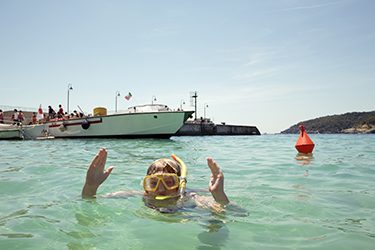
Snorkelers should stay within visibly marked protected areas and pay attention to the boat traffic around them.

For information about DCS, see DAN.org/Health/Decompression.
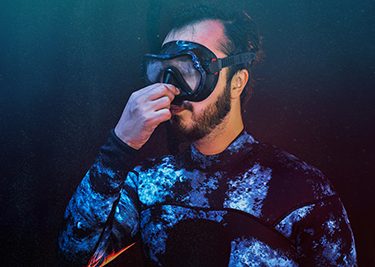
Prevent barotrauma by performing proper equalization.
DAN Customer Service
Mon–Fri, 8:30 a.m. – 5 p.m. ET
+1 (919) 684-2948
+1 (800) 446-2671
Fax: +1 (919) 490-6630
24/7 Emergency Hotline
In event of a dive accident or injury, call local EMS first, then call DAN.
24/7 Emergency Hotline:
+1 (919) 684-9111
(Collect calls accepted)
DAN must arrange transportation for covered emergency medical evacuation fees to be paid.
Medical Information Line
Get answers to your nonemergency health and diving questions.
Mon–Fri, 8:30 a.m. – 5 p.m. ET
+1 (919) 684-2948, Option 4
Online: Ask A Medic
(Allow 24-48 hours for a response.)